The sleepy hamlets of Shekhawati are a treat for any art lover. Ananya Ghosh travels to this off-the-tourist-map destination in Rajasthan and peeps into this painted padlocked world that was once home to one of the most prosperous merchant communities of the country
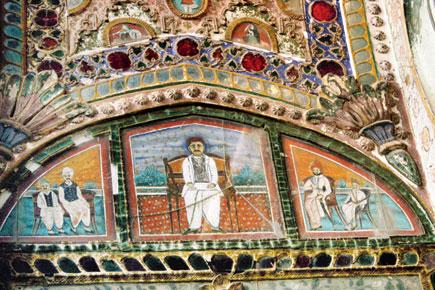
Shekhawati, Rajasthan
Best time to visit: October to March
You need: A week

ADVERTISEMENT
The guidebook makes a passing mention of Shekhawati -- a region in Rajasthan that houses richly frescoed hamlets where walls speak more than its inhabitants. But it is enough to get me curious and head to this ‘open-air art gallery’ of Rajasthan.
When I reach Jhunjhunu, the largest town of the region and also the district headquarter, it is almost evening and I head straight to the main market for the Modi Haveli. After a teeth-clattering roller-coaster ride throughthe narrow, serpentine lanes, when I finally reach Nehru Bazaar, I find myself standing in the middle of a busy vegetable market…looking frescoed havelis. It all seems like some terrible mistake, I must have landed myself on a doppelganger of the town mentioned on the guidebook. Suddenly, I see the sign -- a humble placard that reads: ‘Modi Haveli’. My destination!

Quite an eyeful
I am about to enter the colossal wooden door with intricate carvings and fancy brass iron fittings, when an old man with an eerie resemblance to Mirch Masala’s Om Puri appears from out of thin air. Startled, I take a few steps back.

His stern face breaks into a warm smile as he introduces himself as the caretaker of Ishwardas Modi Haveli and offers to show me around in exchange of R100. I readily agree. As he unlocks each door of this stuck-in-the-time haveli, I find myself confronted with roofs and walls crawling with breathtakingly beautiful and intricate frescos. My guide tells me how four brothers built exact same rooms at four corners of the house to avoid property dispute, how the 365 windows of the haveli were constructed to ensure a constant flow of air inside the building while obstructing the harsh rays of sun from falling directly on the walls, etc. But, I am find myself unable to concentrate on anything but the stunning artworks on display.
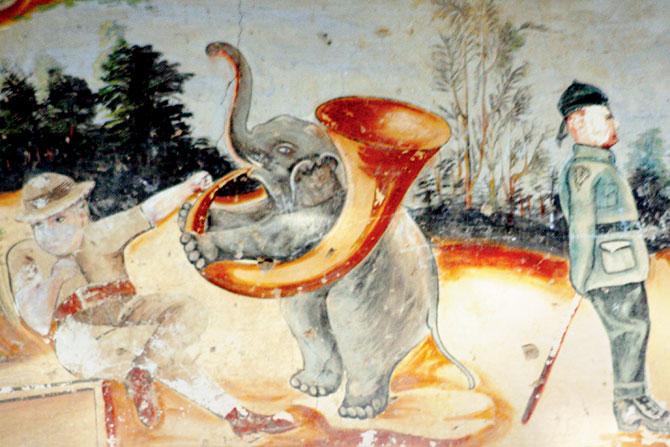
A painted, padlocked world
Unlike other parts of Rajasthan, Shekhawati, which boasts some obscure specks of village-towns that jut out from the arid desert, is yet to make its presence felt on the tourist map. But, when I reach Bissau the next day I realise why this region is called an art lover’s El Dorado.
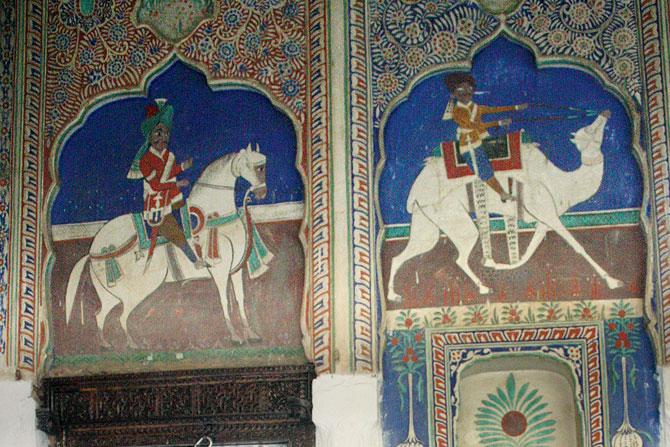
The sleepy hamlet welcomes me with a cacophony of images. The walls, roofs, parapets of every house are plastered with frescos. It is a surreal world inhabited by gods and goddesses, angels and demons, nawabs and maharajahs, as well erotic couples, British Cavalry, mustached Marwari gentry, make-up obsessed ladies, and even cars, trains, telephones, gramophones, balloons and bicycles.The artists (locally known as chiteras) who painted these frescos were hardly discerning when it came to choosing their subject. The result is a quirky mix of sublime and trivial.
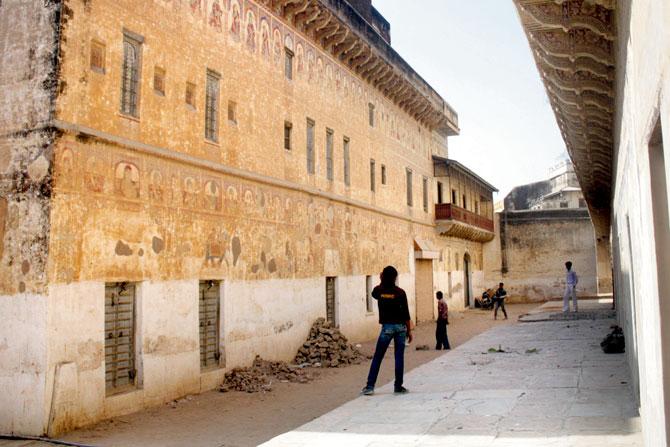
However, although the walls are crowded with mustached men, the houses are all empty and locked. In front of one such house however, I find a caretaker and ask him the mystery behind the locked doors and if I could get a quick sneak peek of the padlocked world. He curtly tells me that the owners resides in Mumbai and ‘Saab’ has given strict instructions to open the gates ‘Only to goras’ foreigners)’. Never knew being an Indian in my own country can be such a disadvantage!
Reaching Ramgarh
My next pit stop is arguably the most profusely painted towns of the region -- Ramgarh. It’s almost an hour’s journey and my thoughts veer towards Jai, Veeru and Gabbar. I could almost hear a spine chilling voice echoing in my brain: "Holi kab hay? Kab hay Holi?"

Just then, the car screeches to a halt. I open my eyes to reality, which consists of a road packed with cars, camel carts, donkeys, porters and general madness and a mass effort to clear the chaos leading in further chaos. Suddenly out of nowhere a man in suit walks up to the car. "Please follow me," he says in calm but authoritative voice. We are desperate to get out of this pandemonium and follow him. The walk ends in front of a heritage property named Ramgarh Fresco. The man introduces himself as the ‘manager’ of the hotel-cum-museum. He offers to show me around and as we go ‘frescospotting’ around the town, he tells me about the origin of this unique style of painting.
The silk route
These small towns of Shekhawati were once part of the Southern Silk Route and home to a rich and flourishing merchant community. As time passed, many members of this community migrated to Bombay and Calcutta where most of them made a fortune trading with the East India Company. Even today, the roots of the country’s most powerful business families, including the Neotias, the Ruias, the Birlas, the Goenkas and the Poddars, can be traced back to this region.
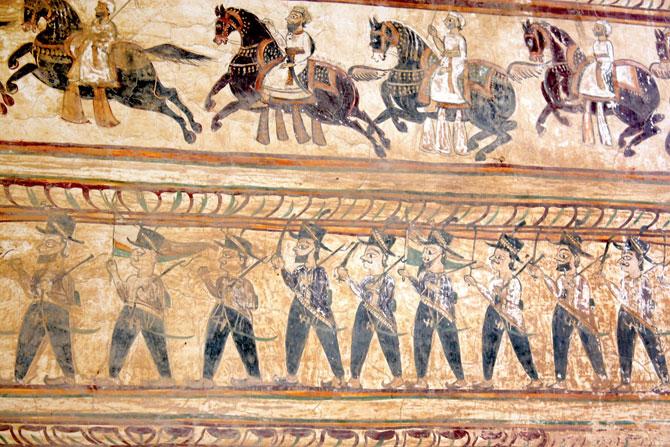
Back then, it was a custom for traders to build four things in their native village -- a haveli, a baoli (well), a mandir and a dharamshala. These slowly became markers of social status -- the more wealthy the businessman, the more lavish the construction and more intricate the frescos.
What started with painting gods and goddesses on the walls to protect the house from outside evil slowly started accommodating common man and his daily life. By the early 20th century, the frescos started reflecting distinct European influences and gave birth to a new style of painting known as the Company Style where airplanes, ships, sofa sets, sewing machines, gramophones, trains, trumpets, and telephones are painted using Rajasthani miniatures and Mughal styles. Most of these painters had no direct contact with the Western world and would depend on the elaborate, often absurd description of the traders back from a business trip abroad.The result would often be a bizarre interpretation of the actual objects. Most frescos that adorn these houses are over 100 to 200 years old and are done in a style similar to the fresco buono method developed in Italy around the 14th century.
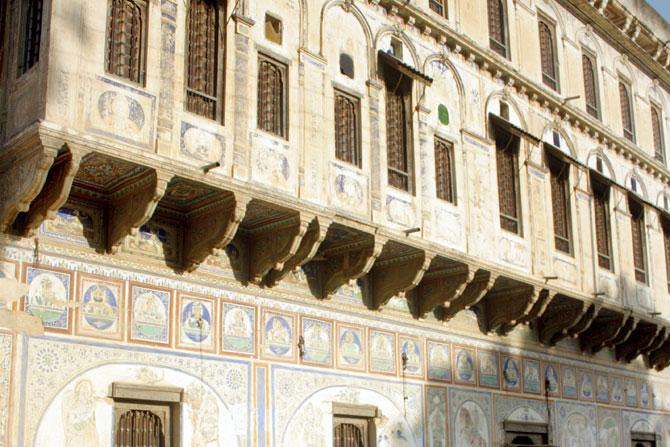
Today, these profusely painted, often dilapidated, havelis that line the dust-laden lanes of these sleepy village towns are just mementos from that prosperous past. Time has blanched their halo and all that remains are scraps of bed-time stories.
 Subscribe today by clicking the link and stay updated with the latest news!" Click here!
Subscribe today by clicking the link and stay updated with the latest news!" Click here!







